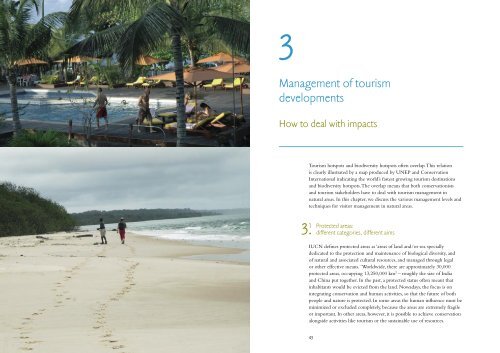OMSLAG 5.indd - IUCN
OMSLAG 5.indd - IUCN
OMSLAG 5.indd - IUCN
You also want an ePaper? Increase the reach of your titles
YUMPU automatically turns print PDFs into web optimized ePapers that Google loves.
3<br />
42 43<br />
Management of tourism<br />
developments<br />
How to deal with impacts<br />
3. 1<br />
Tourism hotspots and biodiversity hotspots often overlap. This relation<br />
is clearly illustrated by a map produced by UNEP and Conservation<br />
International indicating the world’s fastest growing tourism destinations<br />
and biodiversity hotspots. The overlap means that both conservationists<br />
and tourism stakeholders have to deal with tourism management in<br />
natural areas. In this chapter, we discuss the various management levels and<br />
techniques for visitor management in natural areas.<br />
Protected areas:<br />
different categories, different aims<br />
<strong>IUCN</strong> defines protected areas as ‘areas of land and/or sea specially<br />
dedicated to the protection and maintenance of biological diversity, and<br />
of natural and associated cultural resources, and managed through legal<br />
or other effective means. ’ Worldwide, there are approximately 30,000<br />
protected areas, occupying 13,250,000 km 2 – roughly the size of India<br />
and China put together. In the past, a protected status often meant that<br />
inhabitants would be evicted from the land. Nowadays, the focus is on<br />
integrating conservation and human activities, so that the future of both<br />
people and nature is protected. In some areas the human influence must be<br />
minimized or excluded completely, because the areas are extremely fragile<br />
or important. In other areas, however, it is possible to achieve conservation<br />
alongside activities like tourism or the sustainable use of resources.
















